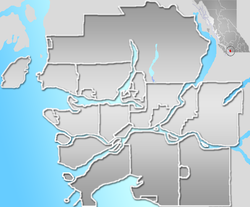The Ismaili Centre, Vancouver is a Shia Ismaili Jama'at Khana, located in the Vancouver suburb of Burnaby, in British Columbia, Canada. Completed in 1985, it is one of six Ismaili Centres worldwide. and was the first purpose-built jamatkhana and Ismaili centre in North America.[1][2] The centre has been the subject of sustained, dedicated academic analysis, and presented as a case study of modern Islamic architecture in the West.[3][4][5]
| Ismaili Centre, Vancouver | |
|---|---|
 The entrance and forecourt, in 2017 | |
| Religion | |
| Affiliation | Shia Islam |
| Rite | Nizari Ismaili |
| Ecclesiastical or organizational status | Jama'at Khana |
| Status | Active |
| Location | |
| Location | 4010 Canada Way, Burnaby, Metro Vancouver, British Columbia |
| Country | Canada |
Location in Vancouver | |
| Geographic coordinates | 49°15′15″N 123°00′49″W / 49.25415°N 123.01373°W |
| Architecture | |
| Architect(s) | Bruno Freschi |
| Type | Jamatkhana |
| Style | Islamic architecture |
| Founder | His Highness the Aga Khan |
| Groundbreaking | 26 July 1982 |
| Completed | 1985 |
| Specifications | |
| Interior area | 3,780 m2 (40,700 sq ft) |
| Dome(s) | Two (maybe more) |
| Materials | Stone |
| Website | |
| the | |
Foundation and establishment
editEstablished by His Highness Aga Khan IV, the 49th hereditary Imam of the Shia Ismaili Muslims, the Ismaili Centre, Vancouver was the first of such centers in North America and the second in a series of six Ismaili Centres currently situated in London, Lisbon, Dubai, Dushanbe, and Toronto.
The foundation ceremony for the new building was held on 26 July 1982,[6] and construction was completed in 1985. During the silver jubilee of His Highness the Aga Khan,[7]: 183 the new building was opened by the former Canadian Prime Minister Brian Mulroney on 23 August 1985.[8]
Architecture and design
editDesigned by the Vancouver architect Bruno Freschi,[9][10] the building was conceived as an 'ambassadorial building' aiming to give visual architectural expression to the expanding Ismaili community in Canada, and designed 'not just for the use of the members of the Ismaili community, but [...] to become part of the fabric of the civil life of the area'.[7]: 136–7 The centre has been described as 'monumental',[11] 'spectacular'[8] and 'sitting harmoniously' within its environment, reflecting 'traditional Islamic architectural vocabulary in modern context, materials, and craftsmanship'.[5] Its footprint is 3,870 square metres (41,700 sq ft), with a basement containing offices and classroom space, and two upper floors, a double-height prayer-hall (reserved for Ismaili worship) and a multi-purpose hall, around a courtyard with a fountain.[5] The prayer-hall is roofed with a series of shallow Turkish-style domes.[12] The design 'attracted international plaudits'.[13]
The faith of Islam is one in which the spiritual and the secular are inextricably linked.[14] As a result, the centre would have to thus reflect both the historical and traditional as well as the contemporary and forward-looking aspirations of the Ismaili community.[peacock prose]
See also
editReferences
edit- ^ Versi, Salima (2010). Make This Your Home: The Impact of Religion on Acculturation: The Case of Canadian Khoja Nizari Isma‗ilis from East Africa (MA thesis (unpublished)). Queen‘s University Kingston. pp. 22, 52.
- ^ Dossa, Parin. "Women's Space/Time: An Anthropological Perspective on Ismaili Immigrant Women in Calgary and Vancouver". Canadian Ethnic Studies/Etudes Ethniques au Canada. 20 (1): 45.
- ^ Kemble, Roger (1985). "Ethnic eloquence: Burnaby Jamatkhana, Burnaby, B.C. architect: Bruno Freschi: Critique". Canadian Architect. 30 (6): 12–17.
- ^ Sherali, Hafiz-Ur-Rehman (1991). Architectural Culture of Islamic Institutions in the West (Master of Architecture thesis (unpublished)). Massachusetts Institute of Technology. pp. 179–219.
- ^ a b c Karimi, Zamila R. (2010). "Spaces of Worship in Islam in the West". Interiors. 1 (3): 265–80, 276. doi:10.2752/204191210X12875837764174.
- ^ Pirani, Khalil Karim (1989). In Search of Appropriate Architecture: A Jamat Khana in Hunza, Pakistan (PDF) (Master of Architecture dissertation (unpublished)). Massachusetts Institute of Technology. pp. 3 fn. 2.
- ^ a b Poor, Daryoush Mohammad (2014). Authority without Territory: The Aga Khan Development Network and the Ismaili Imamate. New York: Palgrave Macmillan.
- ^ a b Karim, Karim H. (2013). "Pluralism, Migration, Space and Song: Ismaili Arrangements of Public and Private Spheres". In Ashley, Susan L. T. (ed.). Diverse Spaces: Identity, Heritage and Community in Canadian Public Culture. Newcastle Upon Tyne: Cambridge Scholars Publishing. pp. 148–69, 155.
- ^ Freschi, Bruno (July 1986). "Burnaby Jamatkhana". Architecture and Urbanism (A+ U). 190: 51.
- ^ Kalman, Harold; Ward, Robin; Roaf, John (2012). Exploring Vancouver: The Architectural Guide. Vancouver: D & M Publishers. p. 296.
- ^ Kassam, Tekijät Tazim R. (1995). Songs of Wisdom and Circles of Dance: Hymns of the Satpanth Ismā'īlī Muslim Saint, Pīr Shams. Albany, N.Y.: State University of New York Press. p. 7.
- ^ Khan, Hasan-Uddin (2009). "The Art and Architecture of the Mosque". In Sajoo, Amyn B. (ed.). A Companion to the Muslim World. London: Tauris. pp. 177–208, 204.
- ^ Hussain, Amir; Scott, Jamie S. (2012). "Muslims". In Scott, Jamie S. Scott (ed.). The Religions of Canadians. Toronto: University of Toronto Press. pp. 167–218, 192.
- ^ "Address by His Highness the Aga Khan on Receiving the 'Tolerance' Award, Tutzing Evangelische Akademie 20 May 2006". European Judaism. 40 (2): 4–8. November 30, 2007. doi:10.3167/ej.2007.400202. ISSN 0014-3006.
External links
edit- Official website
- "Photo Gallery of the Ismaili Jamatkhana and Centre, Burnaby, Canada". Simerg – Insights from Around the World. April 11, 2009.
